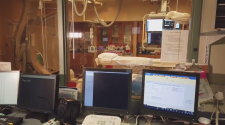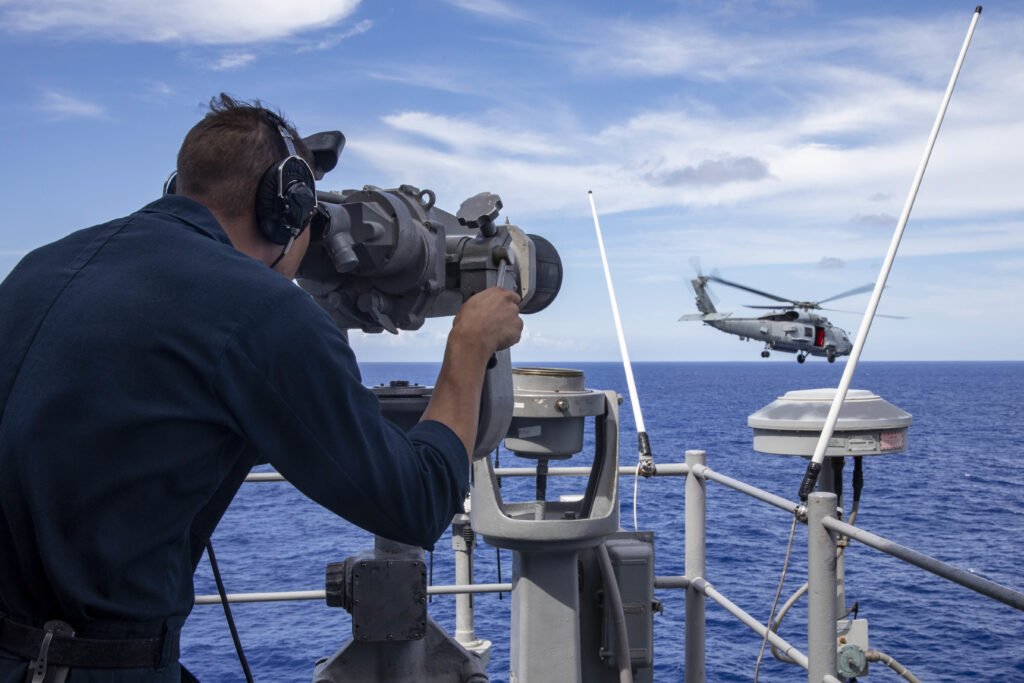A sailor watches an MH-60R Seahawk take off from the USS Wasp during Exercise Black Widow.
WASHINGTON: The Navy’s newest fleet and submarine commands teamed up this week for an intensive anti-submarine drill off the East Coast, waters Navy commanders say are now open game for Russian submarines.
“This is where the fight is…where the competition is. Specifically in the Atlantic [and] the undersea capability of the Russians. We have got to maintain that advantage.” Vice Adm. Andrew Lewis, commander of the new Norfolk-based 2nd Fleet, told reporters.
“It’s pretty well-known now that our homeland is no longer a sanctuary,” Vice Adm. Daryl Caudle, Submarine Forces Atlantic told reporters Wednesday. “So we have to be prepared here to conduct high-end combat operations in local waters, just like we do abroad now because…nothing’s a sanctuary any longer.”
The exercises come as the Navy is developing new capabilities, including unmanned ships, fast-moving frigates, and a new submarine-basing agreement and expanded base with Norway, to meet the rapid modernization of Chinese and Russian undersea fleets as they operate more frequently in the Arctic and could potentially begin creeping up to the US coastline.
But it’s not clear how interested Moscow is in playing near American coasts. Their submarine fleet is primarily concerned with protecting Russian critical infrastructure and its own ballistic-missile submarines, key to Moscow’s second strike capability. There is probably little appetite in Moscow to send its subs on regular long-range, high-endurance missions near US coastlines. The fleet is small and such a far-flung deployment would leave its other assets unprotected.
What the 2nd Fleet may be most interested in close to US shores, said Michael Kofman, director of the Russia Studies Program at the Center for Naval Analysis, are the submarines of Moscow’s 10th Department, which operates several massive nuclear-powered subs which operate separately from the Russian navy.
The agency, also known as the Main Directorate of Deep-Sea Research, has converted several ballistic missile submarines to act as motherships to dock other submarines or unmanned undersea vessels on special deep-dive missions.
This fleet of submarines also can manipulate undersea cables and other undersea infrastructure, using retractable arms that can reach out and grab items off the ocean floor.
“A secondary concern for the United States is the activity of this second navy,” Kofman said. “Think of them as specialized submarines that have a host of capabilities — some of that surrounding fiber optic cable infrastructure on the ocean seabed — but it’s an entirely different set of operations” from the Russian navy.
The “Black Widow” exercise, which started Monday, puts several high-end assets in the water, including the amphibious assault ship Wasp, destroyers USS Arleigh Burke and McFaul, P-8 surveillance planes, helicopters, and two fast-attack submarines.
A key part of the exercise is to work out any flaws in the command and control between the new submarine command and the 2nd Fleet, as the two organizations work though how to coordinate activities. Things learned over this week will help commanders forge a closer working relationship, and iron out the kinks in coordinating and communicating, in future operations.
“Because I have 2nd Fleet now stood up and a true fleet commander, with a theater undersea warfighting commander working for him, it really is a rehearsal,” Caudle said. “So the submarines and surface ships that are involved in this exercise are in a command and control structure that would be identical that if they were deployed to 6th Fleet.”
Late last month, a Russian submarine unexpectedly popped up on the surface in international waters off the coast of Alaska, catching Northern Command by surprise. The sub, part of a larger Russian military exercise, never entered US waters but its proximity was a signal that many Russian naval capabilities have improved greatly since bottoming out in the immediate aftermath of the Cold War.
The Black Widow exercise follows confirmation earlier this month that Norway had made improvements to a port above the Arctic Circle to pave the way for increased visits by US nuclear submarines, providing a major new jumping off point for watching Russia’s active Northern Fleet as it transits into the North Atlantic.
The Russian sub near Alaska appeared just days after the American fast attack submarine USS Seawolf emerged from the Arctic off the coast of Tromso, Norway to take on new crew members. The boat is one of just three Seawolf-class fast attack submarines specializing in intelligence collection, and the Washington-based submarine was likely operating under the Arctic ice before stopping off the Norwegian coast.
Twice over the past year, the US Navy has publicized its nuclear submarines docking in Norway, sending a clear signal to Russia about the American presence in the region and providing a rare glimpse into the secretive world or undersea deployments. The new work will allow American and NATO submarines to pull into the port and replenish, allowing for longer deployments to the critical Arctic region.
The Navy’s increased focus on submarine operations is a key indicator as to what the Pentagon is most concerned about in coming years the Russians and Chinese deploy new subs. “Anti-submarine warfare is a primary mission for everybody in the United States Navy, regardless of what you wear on your chest,” Lewis said.
The Navy’s Medium Unmanned Surface Vessel — still in development — is expected to play a role in hunting subs in the coming years as part of its intel collection capability, providing a risk-free alternative to expensive, crewed ships or aircraft doing circles in the ocean looking for small submarines in the vast expanses of the ocean.
A new report from the Hudson Institute points out that the current approach that uses slow-moving and easily trackable towed arrays “cannot scale to address more than a few adversary submarines at a time after they leave choke points and deploy into the open ocean,” but employing MUSVs towing active and passive arrays, networked with aerial drones, more submarines can be tracked simultaneously.
Adm. Lewis, without naming the MUSV specifically, appeared to underline that point. “The future of undersea warfare, as well as a lot of other warfare, is in the combination of unmanned and manned and the integration of those,” he said.
















